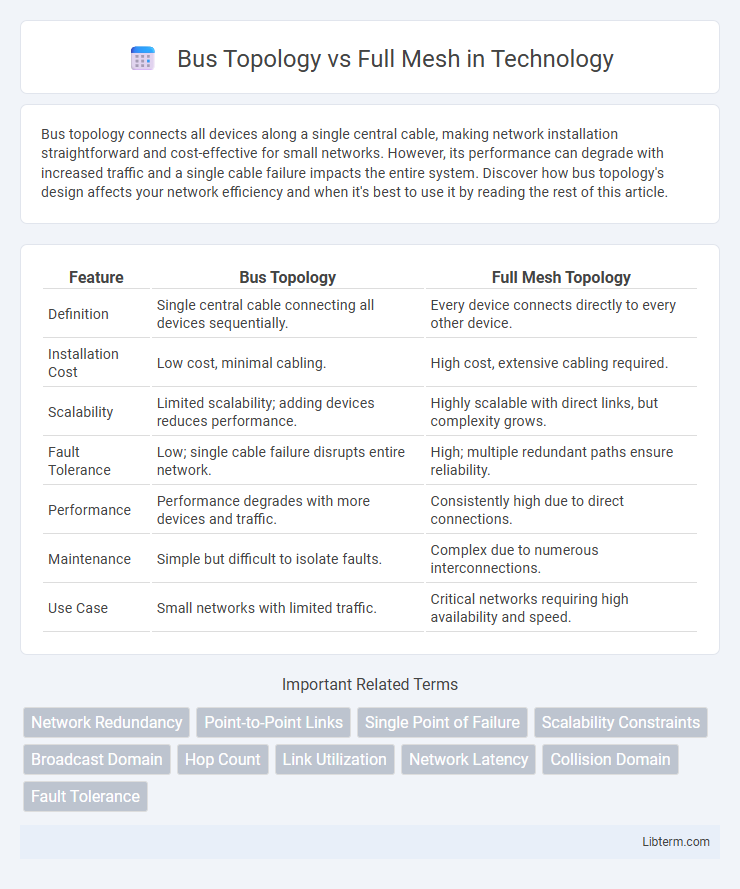Bus topology connects all devices along a single central cable, making network installation straightforward and cost-effective for small networks. However, its performance can degrade with increased traffic and a single cable failure impacts the entire system. Discover how bus topology's design affects your network efficiency and when it's best to use it by reading the rest of this article.
Table of Comparison
| Feature | Bus Topology | Full Mesh Topology |
|---|---|---|
| Definition | Single central cable connecting all devices sequentially. | Every device connects directly to every other device. |
| Installation Cost | Low cost, minimal cabling. | High cost, extensive cabling required. |
| Scalability | Limited scalability; adding devices reduces performance. | Highly scalable with direct links, but complexity grows. |
| Fault Tolerance | Low; single cable failure disrupts entire network. | High; multiple redundant paths ensure reliability. |
| Performance | Performance degrades with more devices and traffic. | Consistently high due to direct connections. |
| Maintenance | Simple but difficult to isolate faults. | Complex due to numerous interconnections. |
| Use Case | Small networks with limited traffic. | Critical networks requiring high availability and speed. |
Introduction to Network Topologies
Bus topology connects all devices through a single central cable, enabling straightforward data transmission but risking network failure if the bus line breaks. Full mesh topology links each device directly to every other device, ensuring high redundancy and fault tolerance but requiring extensive cabling and configuration. Choosing between bus and full mesh depends on factors like network size, fault tolerance needs, and installation complexity.
What is Bus Topology?
Bus topology is a network configuration where all devices are connected to a single central cable, known as the bus or backbone. Data transmitted by any device travels along the bus to reach all other connected devices, making it simple and cost-effective for small networks. However, the entire network can be disrupted if the main cable fails, limiting scalability compared to full mesh topology.
What is Full Mesh Topology?
Full Mesh Topology is a network configuration where every device is directly connected to every other device, creating a robust and highly reliable system with multiple redundant paths. This topology minimizes data transmission delays and maximizes fault tolerance by ensuring that if one connection fails, data can be rerouted through alternate links. Unlike Bus Topology, which relies on a single communication line, Full Mesh Topology's comprehensive interconnectivity supports high-performance environments and critical applications requiring consistent uptime.
Key Differences Between Bus and Full Mesh Topology
Bus topology uses a single central cable, known as the bus, to which all devices are connected, making it cost-effective and simple but prone to network failure if the main cable is damaged. Full mesh topology connects every device to every other device directly, providing high redundancy and fault tolerance at the expense of increased complexity and higher costs due to extensive cabling. Unlike bus topology's linear structure, full mesh offers multiple paths for data transmission, ensuring continuous connectivity even if one link fails.
Advantages of Bus Topology
Bus topology offers a simplified network design that requires less cabling compared to a full mesh topology, making it cost-effective for small-scale networks. Its linear structure makes installation and expansion straightforward, reducing setup time and technical complexity. The minimal hardware requirements and ease of troubleshooting enhance its practicality in environments where budget and simplicity are priorities.
Advantages of Full Mesh Topology
Full mesh topology provides superior reliability by establishing direct connections between every device, ensuring continuous communication even if one link fails. This design significantly reduces latency and data bottlenecks, optimizing network performance for high-demand environments. Enhanced security benefits arise from isolated point-to-point communications, limiting unauthorized access and improving data integrity.
Disadvantages of Bus Topology
Bus topology suffers from limited fault tolerance since a single cable failure disrupts the entire network, causing significant downtime. Its performance degrades as more devices are connected, leading to increased data collisions and network congestion. Troubleshooting and isolating issues within bus topology can be complex due to shared transmission mediums.
Disadvantages of Full Mesh Topology
Full mesh topology faces scalability issues due to the exponential increase in the number of connections as devices grow, resulting in higher installation and maintenance costs. Network complexity and difficulty in managing connections can lead to longer troubleshooting times and increased chances of configuration errors. Limited cost-effectiveness makes full mesh less practical for large-scale networks compared to simpler topologies like bus or star.
Bus Topology vs Full Mesh: Use Cases
Bus topology is ideal for small networks with limited devices, such as home or small office setups, due to its cost-effectiveness and simple implementation. Full mesh topology suits mission-critical applications in large enterprises or data centers, ensuring maximum redundancy and fault tolerance by connecting every device to every other device. Bus topology's ease of installation and lower cable requirements contrast with full mesh's high reliability and complex cabling needs, determining their use cases.
Choosing the Right Topology for Your Network
Bus topology offers simplicity and cost-effectiveness for small networks with minimal devices, but it suffers from limited scalability and low fault tolerance. Full mesh topology provides high redundancy and reliability by connecting every device directly, ideal for critical systems requiring robust communication and minimal downtime. Selecting the right topology depends on network size, budget constraints, required fault tolerance, and performance needs, with bus suited for smaller, budget-sensitive setups and full mesh preferred for high-availability environments.
Bus Topology Infographic

 libterm.com
libterm.com